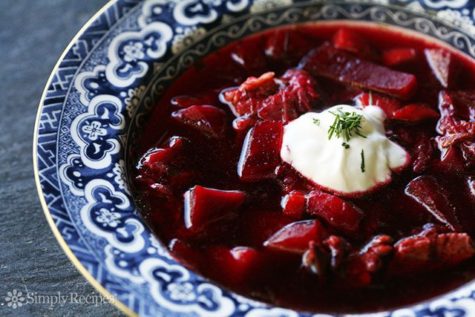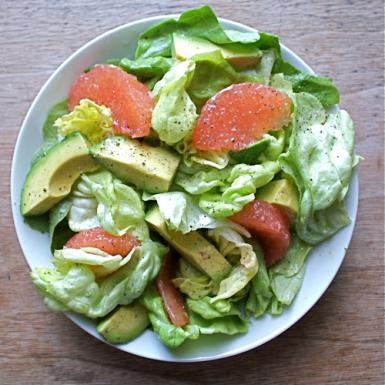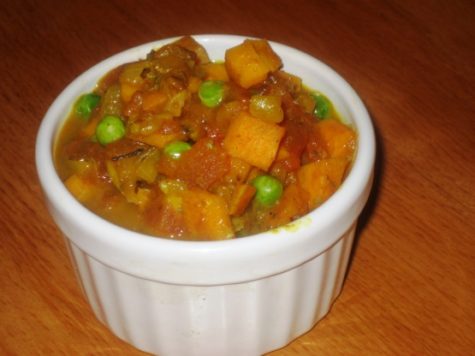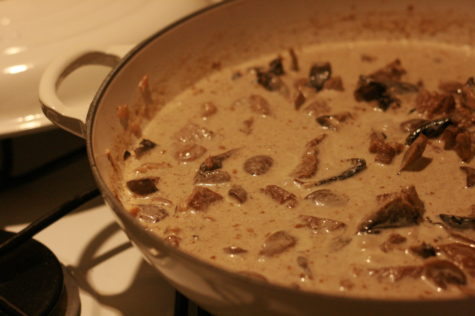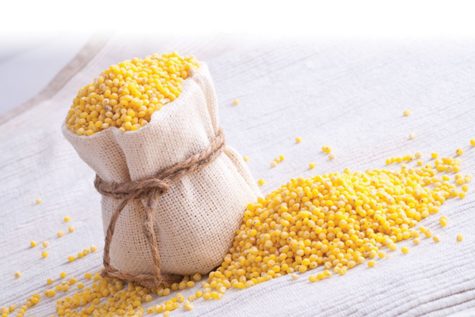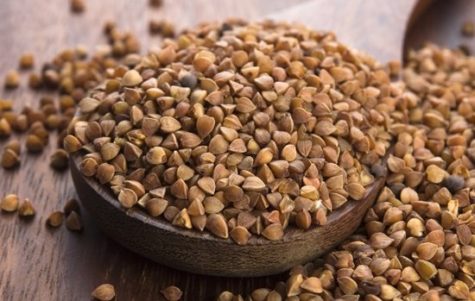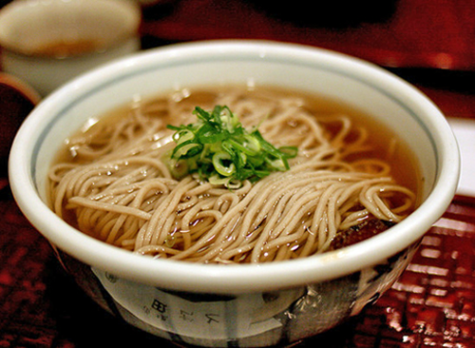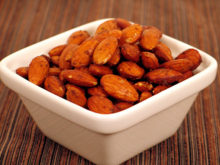Monthly Archives: November 2016
Cranberry Borscht
- 2 cups cranberries
- 3 quarts water
- 2 large onions (sliced)
- 2 cups finely shredded cabbage
- 1 one pound can of beets (julienne or sliced accordingly)
- salt to taste
- 1/4 cup honey
- 1/2 pint sour cream
- 3 hard boiled eggs (sliced)
Cook cranberries in water for about 10 minutes or until skins pop. Put cranberries and liquid through sieve or food mill. Skim the seeds from the top. Add onions and cabbage. Cook for 20 to 30 minutes or until soft. Add beets and beet liquid. Season with salt and honey. Serve hot or well chilled. Garnish with sour cream and slices of hard boiled eggs.
Yield: 8 servings
Source: The Honey Cookbook
Avocado Citrus Salad
The Salad:
- 2 grapefruit
- 3 oranges
- 2 avocados
- Lettuce
The Dressing:
- 1/2 cup lemon juice
- 1/2 cup salad oil
- 1 tsp salt
- 1/4 cup honey
- 1/4 cup raspberry (or any red) jelly or jam
Instructions:
Peel and section grapefruit and oranges. Peel and slice avocados lengthwise. Alternate grapefruit sections, orange sections and avocado slices on lettuce. Combine the dressing ingredients; blend well. Serve the dressing over the salad.
Yield: 6 servings
From The Honey Cookbook
Honey Rose Petal Wine
- 4 quarts fresh rose petals
- 4 gallons boiling water
- 6 lbs honey
- 4 lemons
- 1 quart eglantine (sweet brier rose) leaves- optional
- 1 ounce yeast (baker’s or wine)
Place the rose petals in a clean, warm ceramic crock. Pour the boiling water over these. Cover and let stand for five days, stirring every day. Strain; pour back into the crock.
Add the honey, sliced lemons, and eglantine leaves; stir well. Add the yeast, which has been softened in 1/2 cup lukewarm water. Cover and let stand for two weeks.
Strain again and pour into bottles. Leave the bottles uncapped for three days; then cap and cork. Do not drink for at least two months.
Source: Honey Cookbook
Yam Curry
- 1 generous handful of fresh Mushrooms (sliced)
- 1 small Carrot
- 1 medium Yam
- 1/2 golden Onion
- 1 cup Green Vegetables (zucchini, peas, green beans)
- handful of Bean Sprouts
- Tomato (sliced)
- 1/2 cup (or more) Sour Cream
- 1 to 1 1/2 cups Water
- 1 tsp Curry Powder
- Cumin, Coriander, and/or Turmeric (to taste)
- Salt and Pepper (to taste)
- Flour Mixture
Fry the sliced mushrooms and the seasonings in oil until partly done. Add 1/2 cup of water and the Carrot, Yam, and Onion – all cut into long thin slices. Cook for a few minutes. Add the Green Vegetables and cook for about 5 minutes. Toss in the Bean Sprouts, and enough water to make gravy (about 1/2 to 2/3 cup). Dribble in the Flour Mixture, then add sliced tomato. Simmer one minute and remove from heat. Add the sour cream.
Flour Mixture:
In order to make a smooth gravy, mix 1 or 2 tablespoons of flour with enough water to make a smooth pasty liquid. Add a few drops at a time to the liquid in the pan in which you wish to make gravy. Stir constantly. Heat should be on low. Add salt and pepper. The smoother the flour used, the smoother the gravy.
From: Vegetarian Cookbook
Mushroom Stroganoff
- 1/2 lb sliced Mushrooms
- 1 Medium Onion (chopped)
Fry in butter or oil with:
- 1/4 cup Sherry
- 1 tbsp Paprika
- Pepper (to taste)
When the onions are tender, add 2/3 cup water and make gravy by dribbling in the Flour Mixture. Stir in:
- 1/2 cup (or more) Sour Cream
Serve over noodles.
Flour Mixture:
In order to make a smooth gravy, mix 1 or 2 tablespoons of flour with enough water to make a smooth pasty liquid. Add a few drops at a time to the liquid in the pan in which you wish to make gravy. Stir constantly. Heat should be on low. Add salt and pepper. The smoother the flour used, the smoother the gravy.
From: Vegetarian Cookbook
The Health Benefits of Millet
Most people have not even heard of millet, much less understand the benefits of millet nutrition. And yet, millet is one of the best-kept secrets of our ancient ancestors. Traced back to its origin in China, millet has been used throughout the ages and across many countries.
For centuries millet has been a prized crop in China, India, Greece, Egypt and Africa, used in everything from bread to couscous, and as cereal grain. Millet is even mentioned as a treasured crop in the Bible.
This tiny “grain” is gluten-free and packed with vitamins and minerals. In fact, while it’s often called a grain because of it’s grain-like consistency, millet is actually a seed. It’s often used in birdseed mixture, but if you think it’s just for the birds, you’re missing out on important benefits of millet nutrition for yourself!
The positive effects of Millet:
- Does NOT feed pathogenic yeast (candida),
- Acts as a prebiotic to feed important microflora in your inner ecosystem
- Provides serotonin to calm and soothe your moods.
- Helps hydrate your colon to keep you regular.
- Is alkaline.
- Digests easily.
Health benefits of Millet:
- Magnesium in millet can help reduce the affects of migraines and heart attacks.
- Niacin (vitamin B3) in millet can help lower cholesterol.
- Phosphorus in millet helps with fat metabolism, body tissue repair and creating energy (phosphorus is an essential component ofadenosine triphosphate or ATP, a precursor to energy in your body)
- Millet can help lower risk of type 2 diabetes.
- Fiber from whole grains has been shown to protect against breast cancer.
- Whole grains have been shown to protect against childhood asthma.
It’s not for everyone:
While millet may not contain gluten, it does contain goitrogens. Goitrogens are those substances in food that suppress thyroid activity and can lead to goiter, an enlargement of this very important gland which resides in the throat. Low iodine intake can also lead to goiter.
While the goitrogens in foods that contain them are usually reduced by cooking (such as cruciferous vegetables), cooking actually increases the goitrogenic effect of millet! Therefore, when folks begin eating large amounts of millet bread with a wholesale switch over from wheat, the goitrogenic effects of this simple dietary change can be profound.
Protect your thyroid at all costs! It is a real challenge to unwind the effects of hypothyroidism once this vital gland is weakened or enlarged. Don’t take any chances with your thyroid health by consuming large amounts of millet bread or millet based snacks. If gluten and/or wheat is a problem, then simply reduce bread consumption or use another grain that is both non gluten containing and non goitrogenic such as rice or oats. Occasional millet bread consumption is fine if your thyroid is healthy – just don’t overdo!
Source: Body Ecology and other sources
High Fiber Foods
 High fiber foods bulk up the digested food particles, meaning they are easier to pass and less of a trial for your digestive tract. What follows is a list of common foods along with their fiber content in grams.
High fiber foods bulk up the digested food particles, meaning they are easier to pass and less of a trial for your digestive tract. What follows is a list of common foods along with their fiber content in grams.
- Oatmeal – 1 cup – 3.98 grams
- Whole wheat bread – 1 slice – 2 grams
- Whole wheat spaghetti – 1 cup – 6.3 grams
- Brown rice – 1 cup – 3.5 grams
- Barley – 1 cup – 13.6 grams
- Buckwheat – 1 cup – 4.54 grams
- Rye – 1/3 cup – 8.22 grams
- Corn – 1 cup – 4.6 grams
- Apple – 1 medium with skin – 5.0 grams
- Banana – 1 medium – 4.0 grams
- Blueberries – 1 cup – 3.92 grams
- Orange – 1 large – 4.42 grams
- Pear – 1 large – 5.02 grams
- Prunes – 1/4 cup – 3.02 grams
- Strawberries – 1 cup – 3.82 grams
- Raspberries – 1 cup – 8.36 grams
Source: WHFoods
The Health Benefits of Buckwheat
Buckwheat has an impressive catalog of nutritional properties:
- Non-GMO (It requires hardly any chemicals to grow well because it naturally grows so quickly).
- High quality proteins (it contains all 9 amino acids)
- Good energy booster (rich in iron and antioxidants
- Naturally contains vitamins and minerals (including zinc, copper and niacin)
- Great for digestion
Because of it being an insoluble fibrous food, buckwheat is essential for cleaning and strengthening intestines. Insoluble fiber also reduces the secretion of bile acids and lowers triglycerides (blood fats). This is particularly good for those suffering with IBS-D, or anybody who has stomach trouble immediately after consuming foods.
Full of healthy fats:
Anybody looking to remain satiated will know that eating plenty of healthy fats is the way forward. Rather than stocking up on high-calorie, low-energy foods such as bread and processed foods, foods high in healthy fats keep you fuller for longer and see that your nutrition quota is also met. Healthy fats are especially great for IBS sufferers as we need to eat small meals, regularly – the healthy fats mean sugar and fat cravings don’t come about to instigate any flare-ups.
Impressive fiber levels:
Although it depends which type of digestive ailment you suffer from, most people will be thankful for a little added fiber to their diet. High fiber foods bulk up the digested food particles, meaning they are easier to pass and less of a trial for your digestive tract. With 4.54 grams of fiber in just 1 cup, you can see that buckwheat is incredibly high in fiber.
Low glycemic index:
The great thing about buckwheat is that it has a low GI of 54, which means it lowers blood sugars and digests the glucose more slowly than similar products like rice or wheat. Studies have further found that whole buckwheat groats contributed to significantly lowered blood glucose and insulin responses than when the participants ate refined wheat flour products. Whole buckwheat also scored highest on their ability to satisfy hunger.
What can you do with buckwheat?
You can buy raw buckwheat from just about any supermarket or food store in the wholefoods section. I recommend playing with it and seeing what interesting, healthy recipes you can make with it. You can use buckwheat flour as a gluten free alternative when making pancakes and other breads. Soba or buckwheat noodles are a great substitute for pasta, particularly if you are on a gluten free diet.
A Few Quick Serving Ideas
- Combine buckwheat flour with whole wheat flour to make delicious breads, muffins and pancakes.
- Cook up a pot of buckwheat for a change of pace from hot oatmeal as a delicious hearty breakfast cereal.
- Add cooked buckwheat to soups or stews to give them a hardier flavor and deeper texture.
- Add chopped chicken, garden peas, pumpkin seeds and scallions to cooked and cooled buckwheat for a delightful lunch or dinner salad.
Source: My Wellbeing Journal
Simple Boiled Noodles
Pasta is made from grain and can be used as a base for a meal. When using noodles with reduced or no wheat, use the shock method. Buckwheat (soba), corn, and rice noodles are delicate. Shocking allows the noodles to cook thoroughly and gently. The cold water temporarily halts the cooking of the outside of the noodles so the inside of the noodles can catch up.
- 4 quarts of water for up to 16 ounces of noodles
- ¼ tsp sea salt for 4 quarts of water, for unsalted noodles
Procedure – Bring water to a boil. Add sea salt if needed. Add noodles and stir to separate them. Bring to a rolling boil. Add ½ cup cold water and stir noodles. Bring to a rolling boil a second time. Immediately, add ½ cup cold water and stir noodles. Bring to a rolling boil a third time. Add ½ cup cold water and stir noodles. Bring to a rolling boil again. Noodles are done when they are the same color inside and out. Drain. Rinse in cold water. Drain. Rinse and drain again, if needed, until noodles are cooled.
Yield: 5 to 6 cups per 8 ounces of noodles
Source: Ohsawa Macrobiotics
Simple Roasted Nuts and Seeds
- almonds, 12 minutes
- pumpkin seeds, 7 minutes
- sunflower seeds 10 minutes
Procedure – Roast nuts or seeds in the oven when roasting a large quantity. Place one layer of any kind of nut or seed on a baking sheet. Place in a pre-heated, 350-degree oven. Roast for the times indicated, until fragrant, beginning to pop, and browning. Stir occasionally.
If desired, add soy sauce after roasting. Place hot roasted nuts or seeds in a bowl. Add 3 or 4 drops soy sauce per ¼ cup nuts or seeds.
Source: Ohsawa Macrobiotics
